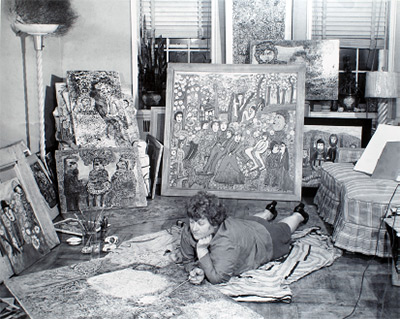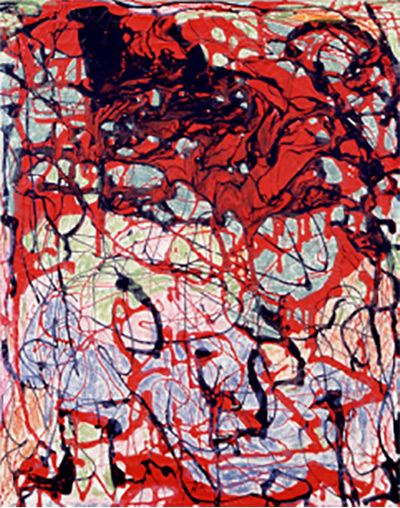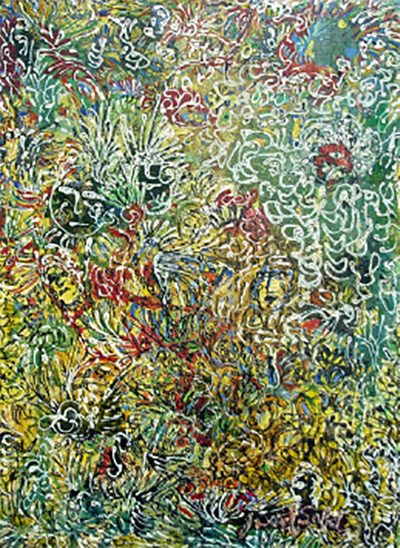In 1943, The Arts Club of Chicago presented an important catalogued exhibition, American Primitive Painting of Four Centuries, curated by Sidney Janis, one of the foremost exponents of American Primitive painting. Major works of the 17th, 18th and 19th century were presented, including Edward Hicks “The Peaceable Kingdom.” In the 20th century, works are included by John Kane, Horace Pippin, Morris Hirschfield, “Mother” Moses, and last, one painting titled “Spring Festival” by Janet Sobel. By this time, Janet Sobel, a Brooklyn grandmother and housewife who immigrated from Russia at the turn of the century, had already produced a large body of work, begun four years earlier when, at the age of 56, she began to paint for the first time. “Spring Festival” is also featured front and center in an extraordinary photograph taken in 1944 of Janet Sobel in her home and studio in Brighton Beach, Brooklyn. It is an indication of her stature as an artist in 1944 that this photograph was taken by a well-known photographer, Ben Schnall, and by some accounts taken for possible inclusion in a Life magazine article, which never ran.
What do we know about this amazing and enigmatic women, who, as art historian Deborah Goldberg wrote in a biography of Sobel, “. . . served her roast chicken, gefilte fish and chicken soup to those who visited her home, including luminaries like Andre Breton, the founder of Surrealism; Peggy Guggenheim; Dewey; Janis; Max Ernst; and his son Jimmy (Breton and the Ernsts played chess with the Sobel family)”? Although there is conflicting scholarship, Janet Sobel was born Jennie Lechovsky near Ekaterinoslav, Ukraine, in 1893, during a period when upheavals — cultural, political and economic — had begun to challenge settled ways. Her father, Bernard Lechovsky, was killed in a pogrom, and her mother, Fanny Kahn Lechovsky, who worked as a midwife, emigrated with her three children to the United States in 1908. Art historians such as Gail Levin have conjectured that the early childhood trauma of violence, fear and loss in Russia, coupled with the emotional climate of World War II, where two of her sons served, are a source of psychic disturbance which fuels her works. Janet married Max Sobel, a goldsmith and engraver who was also from the Ukraine. The couple had five children, born between 1911 and 1927. Janet Sobel received little formal education, but knew Russian, Yiddish and English, and she studied the Bible and Greek philosophy. Like her husband, she appreciated culture and encouraged her children’s interest in music, art, language and ideas. It wasn’t until the late 1930s that Max Sobel’s business manufacturing costume jewelry would begin to prosper, and in 1941 the family moved to Brighton Beach, overlooking the water.
By most accounts, Janet Sobel first began experimenting with art materials around 1939. One story has it that she began to draw on top of some of the drawings that her son Sol brought home from his art classes at the Educational Alliance. Another is that Sol, while still in high school, had won a scholarship to the Arts Students League, which, against his mother’s wishes, he sought to give up. When she tried to convince him to continue, he reportedly exclaimed: “If you are so interested in art, why don’t you paint?” Whichever version is accurate, both agree that Sol provided his mother with paint brushes and materials. In an interview in 1962, Sobel told an interviewer “. . . she heard a voice tell her she must paint. So she started oil painting as easily as most women would toss off a pan of muffins.” Through her son Sol’s efforts, Sobel’s work was admired by Sidney Janis, John Dewey and others, and from 1943 through 1946, Janet Sobel became a powerful presence in the New York art world. She exhibited in the 27th Annual at the Brooklyn Museum in 1943 (she would also exhibit there in 1944 and 1945). Sidney Janis proclaims that Sobel “is no longer primitive”, that “her paintings are filled with unconscious surrealist phantasy,” and includes her in the important Abstract and Surrealist Painting in America exhibition that travels throughout the country in 1944. That same year would see Janet Sobel’s first one person show at Puma Gallery, run by the surrealist Ferdinand Puma, who, in his 1947 book on Surrealism places Sobel “among the newcomers” along with Matta, Gorky, Tobey, Hoffman and Pollock, among others. John Dewey becomes a proponent of Sobel’s work, and writes in the catalogue forward for the Puma show:
It is a pleasure to respond to an invitation to say a few words in connection with the first one- man show of Janet Sobel, some of whose work is appearing contemporaneously in a traveling exhibit of American Abstract and Surrealist painting, which is now touring the Western states to San Francisco.
The work of Mrs. Sobel would be of great human interest if only because she commenced painting, with no previous set instruction after she had reached a fairly advanced age, but what is more striking is its union of youthful spontaneity and a certain characteristic individualized finish.
Her work is extraordinarily free from imitativeness and from self-consciousness and pre- tense. One can believe that to an unusual degree her forms and colors well up from a subconsciousness that is richly stored with sensitive impressions received directly from contact with nature, impressions which have been reorganized in figures in which color and form are happily wed.
As in the case of all interesting and genuine productions, different observers will be struck with different notes.
The quality I myself seem to feel most vividly is that of the interblending of the abundant life of vegetation with the sparser life of human beings in a kind of brooding maternal wholeness.
An Art News reviewer notes, “Janet Sobel, at the good age of fifty, and after only five years of painting, has launched her first exhibition at the Puma Gallery. Self-taught, imaginative, witty, and wholly unorthodox, this Russian-born artist has improvised a series of fantasies curiously both sophisticated and naïve.” The reviewer also remarked on her “weird personalized world of commingled images com- posed of forms sketched over forms and sprinklings of gay flowers” and singled out her paintings on glass.
Of particular interest is Sobel’s drip technique, or “white writing,” a term that was used to describe Mark Tobey’s work. The reviewer for Art Digest pointed out the “recurring leit motif of near Persian richness of color and inventive design” and commented: “Some of the earlier all-over patterns suggest tapestry weaving. In later canvassed, where the artist has used her own version of ‘white writing,’ you may have to look sharply to see the forms and faces that emerge double image-wise in jewel toned duco, from behind an intricate curtain of cobwebby white lace.”
In 1944, Sobel was also in a group exhibition at Norlyst Art Gallery in New York, curated by Eleanor Lust and Jimmy Ernst. Possibly through Jimmy Ernst and his father Max Ernst the work would come to the attention of Peggy Guggenheim, and in 1945 Sobel is invited to exhibit, along with Louise Bourgois, Irene Rice Pereira, Kay Sage, and others, in The Women at Guggenheim’s Art of This Century gallery. In 1945 Ad Reinhardt drew his famous illustrated chart, “How to Look at Modern Art in America.” He located Sobel next to Mark Tobey, and in close association with others such as Arshile Gorky. In 1946, Guggenheim, who at this time is also showing Jackson Pollock, gives Sobel a one person exhibition at her Art of This Century Gallery. Sidney Janis essay is particularly interesting in the light of the development of Abstract Expressionism: “More and more her work is given over to freedom and imaginative play. Her autodidactic techniques in which automatism and chance effectively predominate, are improvised according to inner demands.” Janis also says “Janet Sobel probably will be eventually known as the most important surrealist painter in this country.” By the end of 1946, in a radio interview with WCBS, she is introduced as “one of America’s most talked about Surrealist painters.”
Today, Sobel is best known for her influence on Jackson Pollock, who most probably first saw her work with Clement Greenberg in 1944 at the Puma exhibition, at a time when her work had evolved from more primitive, Chagall-like figuration, to more surrealist and all-over paintings, many of which feature poured or dripped pigment. Greenberg would write:
Back in 1944, [Pollock] had noticed one or two curious paintings shown at Peggy Guggenheim’s by a ‘primitive’ painter, Janet Sobel (who was, and still is, a housewife living in Brooklyn). Pollock (and I myself) admired these pictures rather furtively — the effect — and it was the first really “all-over” one that I had ever seen, since Tobey’s show came months later — was strangely pleasing. Later on, Pollock admitted that these pictures had made an impression on him.
But later in 1946, Sobel moves from Brooklyn, with her family, to Plainfield, New Jersey, and although she continues to paint, she all but vanishes from the art world, and only exhibits at a local gallery. Although she continues to paint (and by most accounts continues until at least 1962), she never receives any recognition until the end of her life, when William Rubin at the Museum of Modern Art, who is researching Pollock, visits her, bedridden, and selects two of her 1945 all over drip paintings for MOMA’s collection. The painting Rubin purchased is exhibited at MoMA’s exhibition Recent Acquisitions: Painting and Sculpture, July 27–September 13, 1970. It is show again in 1998 when it is exhibited at the time of MoMA’s important Jackson Pollock — the wall text next to Pollock’s drip painting acknowledges the influence:
Pollock’s radical new method of pouring, dripping, and spattering paint emerged in 1947, but the poured passages in these three abstract works from 1943 make it clear that he had explored such possibilities years before. Already, in a workshop in 1936, the Mexican painter David Siqueiros had encouraged Pollock to fling, pour, and spatter paint. Pollock could also have been aware of the use of poured or dripped paint in the work of many other artists, from André Masson and Joan Miró through Hans Hofmann and Janet Sobel.
It is not until the 1980s that Sobel begins to be discussed, and mostly in the context of her drip paintings and involvement with Abstract Expressionism. Jeffrey Wechsler discusses her work in detail in the catalogue for his 1989 show, Abstract Expressionism: Other Dimensions; An Introduction to Small Scale Painterly Abstraction in America, 1940–1965, at the Jane Voorhees Zimmerli Art Museum, Rutgers. Ann Eden Gibson will discuss Sobel at some length in her book, Abstract Expressionism: Other Politics in 1997. Deborah Goldberg will write a lengthy biography in American National Biography in 1999. In 2001 Gary Snyder Fine Art presents the first one person exhibition of Janet Sobel’s work since 1946. The San Diego Museum purchases one of the drip paintings, and Roberta Smith writes an important review, illustrating one of Sobel’s drip paintings:
Jackson Pollock may have broken the ice, in Willem de Kooning’s well known phrase, but Janet Sobel definitely helped crack it. Using her son’s art materials, this Ukraine-born Brighton Beach mother of five took up painting in 1937 at the age of 43. Within a few years, she was making small abstractions covered with paint dripped in continuous, looping lines.
The Snyder Gallery’s forty-one-work exhibition — the first since 1946 — reveals a complex mix of innate Outsider, folk and Surrealist instincts. Sobel’s first efforts show a flair for a primitivist figuration that recall early Chagall and presage early Dubuffet and for profuse floral patterns reminiscent of Ukrainian peasant art.
But equally innate was a need to exploit materials of all kinds (including sand). Ditto all-over patterns and surfaces, which might entail repeating faces, herringbone marks, splattered watercolor or zigzagging pencil lines. If her drips weren’t vivid enough, she didn’t mind outlining them in ink, and helping to invent Abstract Expressionism did not end her imagistic work. Her main goal was visual intensity, which she achieved with impressive regularity.
Starting out in the vicinity of Kandinsky and Klee and ending nose to nose with Pollock, Sobel’s work is further proof of modern- ism’s impure, nonlinear paths. It is great that her short strange career is visible again. May it remain so.
Gail Levin, who wrote the catalogue forward for the Snyder show, will expand her essay in Women’s Art Journal, and Edward Gomez writes an essay for Raw Vision, placing her for the first time in the context of “Outsider Art”, and writes: “What is clear is that Sobel’s art has emerged as a fascinating, unexpected bridge between the art history of the self-taught and the art history of their more academically trained counterparts who have been and are more readily accepted by the mainstream art establishment.” In 2004, the Los Angeles Museum of Art purchased Sobel’s masterpiece “Burning Bush” and then includes it in its exhibition, In Wonderland: The Surrealist Adventures of Women Artists in Mexico and the United States. Carolyn Jones will write about Sobel and include illustrations of her work in the Jewish Museum’s exhibition, Action/Abstraction: Pollock, de Kooning, and American Art, 1940–1976. Major early, surrealist and drip paintings by Sobel are acquired by the Crystal Bridges Museum of American Art, and one of Sobel’s drip paintings is exhibited in the American Folk Art Museum.
Art in the early 1940s powerfully emerged in reaction to the dominant but opposing styles of American Social Realism and American Abstraction, and responded to the cataclysm that was World War II. It is a period that would give rise to more gestural and spontaneous painting, to an interest in the unconscious and the sub-conscious mind, and a deep questioning in the midst of the profound emotional conflict of wartime. Janet Sobel’s work emerges during this time, and deserves to be studied within this context.





Gary Snyder Fine Art